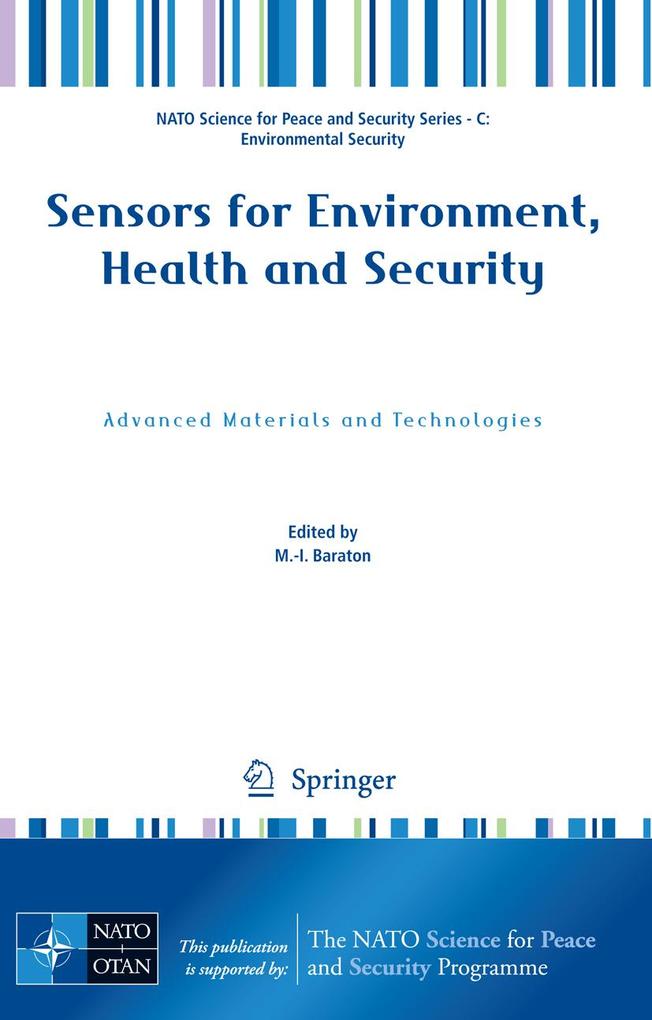
Sofort lieferbar (Download)
The NATO Advanced Study Institute on "Sensors for Environment, Health and Security: Advanced Materials and Technology" was held in Vichy (France) on September 16-27, 2007 where more than 65 participants, ranging from Ph. D. students to experienced senior scientists, met and exchanged ideas and know-how in a friendly atmosphere. The present book intends to cover the main topics of this NATO ASI through 32 chapters distributed over two parts (Part I: "Materials and Technologies" and Part II: "Applications to Environment, Health and Security"). The scientific programme of the NATO ASI consisted in 28 1-hour lectures given by 14 invited lecturers, 5 additional 1-hour lectures given by seminar speakers, 22 oral presentations by selected ASI participants and a poster session. The programme was divided into four sessions: (1) Advanced materials and technologies; (2) Sensors for environment; (3) Sensors for health; (4) Sensors for security. During the "Advanced Materials and Technologies" session (Part I of the present book), the lectures were dedicated to critical analyses of current methods for the synthesis of materials, nanomaterials (nanoparticles, nanowires, nanotubes, . . .) and nanocomposites to be used for the fabrication of sensing devices, mainly semiconductor sensors. Among the synthesis methods, chemical (sol-gel, etc. ) and physical methods (laser deposition, DC magnetron sputtering, etc. ) were discussed. Several lectures addressed characterization techniques and it was concluded that the physical and chemical control of the materials/nanomaterials, including surface chemistry, remains a key issue for the reproducibility of the final device.
Inhaltsverzeichnis
Materials and Technologies. - Metal Oxide Nanocomposites: Synthesis and Characterization in Relation with Gas Sensing Phenomena. - Spectroscopic Study of the Gas Detection Mechanism by Semiconductor Chemical Sensors. - Material Growth and Fundamental Material Characterization Techniques. - Mesoporous Indium Oxide for Gas Sensor Applications. - Synthesis and Examination of Hexagonal Tungsten Oxide Nanocrystals for Electrochromic and Sensing Applications. - Tin Oxide from Organo-Metallic Compounds: Material S Properties and Sensor Characteristics. - Defect Chemistry of Sensor Materials. - Light-Induced Generation of Singlet Oxygen in Porous Silicon. - Selectivity Improvement of Semiconductor Gas Sensors by Filters. - Systems and Set-ups for Effective Sensing Response Applications. - Carbon Composite Electrodes Applied for Electrochemical Sensors. - Photonic Sensors for Health and Environmental Monitoring. - Sensors Based on Technology Nano-on-Micro for Wireless Instruments Preventing Ecological and Industrial Catastrophes. - Development of a Parallel-Computing Embedded Telemetry System for Voltammetric Microsensor and Biosensor Applications. - Inductively Coupled Telemetry. - Applications to Environment, Health and Security. - Biosensors. - Bacteria Detection Biosensors. - Surface Chemistry to Bridge Inorganic Biosensor Surfaces and Biological Materials. - Singlet Oxygen Generation and Detection for Biomedical Applications. - Response of Nerve Cell to Inhibitor Recorded by Aluminium-Gallium-Nitride FET. - Microelectronics-Based Biosensors for the Detection of Proteins and Nucleic Acids. - Bionano-Microbiology. - Optical Sensors for Carbon Dioxide and Their Applications. - Oxygen Indicators in Food Packaging. - Sensory Conversion Devices. - Development of Biological Sensors Based onScreen-Printed Electrodes for Environmental Pollution Monitoring. - Development of Flow Immunosensors for Organic Pollutants. - Sensors for Monitoring Air Quality in Earth and Space Environments. - Determination of the Mutagenic Effects of Pollution by AMES and Neural Networks. - Polyaniline-Based Environmental Gas Sensors. - Sensor Science for National Security. - Radiation and Nuclear Materials Detection Research and Development at ORNL.
Produktdetails
Erscheinungsdatum
25. November 2008
Sprache
englisch
Seitenanzahl
497
Dateigröße
32,67 MB
Reihe
NATO Science for Peace and Security Series C: Environmental Security
Herausgegeben von
M. -I. Baraton
Verlag/Hersteller
Kopierschutz
mit Wasserzeichen versehen
Produktart
EBOOK
Dateiformat
PDF
ISBN
9781402090097
Entdecken Sie mehr
Bewertungen
0 Bewertungen
Es wurden noch keine Bewertungen abgegeben. Schreiben Sie die erste Bewertung zu "Sensors for Environment, Health and Security" und helfen Sie damit anderen bei der Kaufentscheidung.









